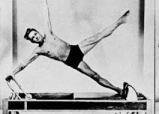PILATES is a physical exercuse developed in the early 20th century by Joseph Pilates.
The original six principles were concentration, control, center, flow, precision, and breathing.
Control
“Contrology” was Joseph Pilates’ preferred name for his method and it is based on the idea of muscle control. “Nothing about the Pilates Method should be haphazard. The reason you need to concentrate so thoroughly is so you can maintain control of every aspect of every moment.”
Concentration
Pilates demands intense focus: “You have to concentrate on what you’re doing all the time. And you must concentrate on your entire body for smooth movements.” This is not easy, but in Pilates the way that exercises are done is more important than the exercises themselves.
Centering
In order for the practitioner to attain control of their body they must have a starting place: the center. The center is the focal point of the Pilates method. Many Pilates teachers refer to the group of muscles in the center of the body— the abdomen, lower and upper back, hips, buttocks, and inner thighs—as the “powerhouse”. All movements in Pilates should begin from the powerhouse and flow outward to the limbs.
Flow or efficiency of movement
Pilates aims for elegant sufficiency of movement, creating flow through the use of appropriate transitions. Once precision has been achieved, the exercises are intended to flow within and into each other in order to build strength and stamina. In other words, the Pilates technique asserts that physical energy exerted from the center should coordinate movements of the extremities: Pilates is flowing movement outward from a strong core.
Precision
Precision is essential to correct Pilates: “concentrate on the correct movements each time you exercise, lest you do them improperly and thus lose all the vital benefits of their value”. The focus is on doing one precise and perfect movement, rather than many halfhearted ones. Pilates is here reflecting common physical culture wisdom: “You will gain more strength from a few energetic, concentrated efforts than from a thousand listless, sluggish movements”. The goal is for this precision to eventually become second nature, and carry over into everyday life as grace and economy of movement.
Breathing
Breathing is important in the Pilates method.
Joseph Pilates saw considerable value in increasing the intake of oxygen and the circulation of this oxygenated blood to every part of the body. This he saw as cleansing and invigorating. Proper full inhalation and complete exhalation were key to this. “Pilates saw forced exhalation as the key to full inhalation.” He advised people to squeeze out the lungs as they would wring a wet towel dry.
In Pilates exercises, the practitioner breathes out with the effort and in on the return. In order to keep the lower abdominals close to the spine; the breathing needs to be directed laterally, into the lower rib cage. Pilates breathing is described as a posterior lateral breathing, meaning that the practitioner is instructed to breathe deep into the back and sides of his or her rib cage. When practitioners exhale, they are instructed to note the engagement of their deep abdominal and pelvic floor muscles and maintain this engagement as they inhale. Pilates attempts to properly coordinate this breathing practice with movement, including breathing instructions with every exercise. Above all, learn to breathe correctly.


Leave a comment